At the recent American Society of Hematology (ASH) annual meeting in San Diego, I had the opportunity to hear a few presentations on Acute Myeloid Leukemia (AML).
Those of you familiar with the ASH annual meeting will know that most of the oral presentations for the biology and therapies take place in simultaneous sessions on Monday. This sadly results in many session conflicts if you want to follow several products, pathways or multiple disease areas.
It’s unfortunate that there’s no virtual meeting such as at ASCO or that presentations are not more spread out during the meeting. My AML update is therefore focused specifically on FLT3 inhibition.
A good definition of AML comes from a recent paper in the journal, “Blood” where Yang Shen and colleagues from the Shanghai Institute of Hematology and other Chinese institutions describe it as:
“A group of heterogeneous diseases with considerable diversity in terms of clinical behavior and prognosis.”
A lot of work has been done in identifying the cytogenetic abnormalities associated with AML. Considerable effort has been spent in attempting to correlate the molecular changes with clinical outcome.
In their Blood paper, Shen noted that in more than 50% of AML patients, no cytogenetic markers can be found. In an analysis of 1185 patients, they found:
“A correlation pattern among NPM1, DNMT3A, FLT3, IDH1, CEBPA, and TET2 mutations. Multivariate analysis identified DNMT3A and MLL mutations as independent factors predicting inferior overall survival (OS)”
What this research highlights is the challenges in attempting to target specific mutations in AML, such as FLT3, when multiple mutations are associated with the disease.
FLT3 has been shown to be prognostic of poor survival, but is it an attractive molecular target in AML?
That was the question asked by Catherine Smith (UCSF) in an oral presentation at ASH 2011. She first noted that FLT3 is over over-expressed in the majority of AML, and is one of the most commonly mutated genes (~20%). Patients with internal tandem duplications (ITD) of FLT3 have been shown to have a worse prognosis.
But is FLT3 a driver lesion in AML?
(For an excellent review of the difference between driver and passenger mutations see Sally Church’s video interview with Gordon Mills at ECCO/ESMO 2011 on Pharma Strategy Blog.)
Smith noted that a “lack of clinical efficacy called into question validity of FLT3 as a therapeutic target.” Only sorafenib has anecdotal reports of a complete remission, she noted.
Using Next Generation Smart Single Molecular Real Time Sequencing, Smith evaluated the drug resistant mutations in 8 patients with acquired resistance to AC220 (quizartinib), a selective FLT3/KIT inhibitor currently in development by Ambit Biosciences & Astellas.
Smith concluded that:
- FLT3-ITD is a valid therapeutic target in human AML
- Mechanism of action of AC220 in AML involves FLT3 inhibition
- FLT3 “gatekeeper” and activation loop mutations represent high value targets for next generation FLT3 inhibitors.
AC220 shows efficacy in relapsed/refractory AML
In a poster presentation at ASH 2011 (abstract #2576), Jorge Cortes (MD Anderson Cancer Center), presented updated interim results for AC220 in FLT3-ITD positive refractory/relapsed acute myeloid leukemia.
Cortes concluded from the phase 2 open-label trial:
- Preliminary data suggest that AC220 (quizartinib) achieves clinically meaningful responses in patients with both refractory and relapsed FLT3-ITD+ AML
- Many patients were successfully bridged to HCST [hematopoietic stem cell transplantation]
- These encouraging efficacy results and an acceptable high-risk profile support continued evaluation of AC220 (quizartinib) in mono- and combination therapy.
I was pleased that Ambit Biosciences made it easy to obtain a copy of their poster by using a QR code. Both Novartis and BMS also used QR codes on their posters at the ASH meeting.
As more people attending meetings have smartphones and iPads, being able to email or download a PDF of a poster by scanning a QR code is becoming more accepted. I currently scan all paper copies of posters, so obtaining an electronic PDF version in the first place is more time efficient, as well as being ecologically friendly.
Two other FLT3 presentations by Catherine Smith from the University of California at San Francisco (UCSF) also caught my attention at ASH.
PLX3397 is a FLT3 inhibitor in early-stage clinical development
In a presentation with colleagues from the University of Pennsylvania and Plexxikon, Smith evaluated the in-vitro activity of PLX3397, a selective FLT3 inhibitor.
Readers may recall that PLX3397 was mentioned in my post from the 2011 San Antonio Breast Cancer Symposium on targeting macrophages in breast cancer.
Smith noted that a phase 1/II study of PLX3397 in FLT3-ITD+ relapsed/refractory AML is ongoing. This certainly looks like an interesting compound to watch.
Ponatinib shows clinical activity against AC220-resistant FLT3-ITD mutants
In another excellent presentation by Catherine Smith, she looked at the potential for ponatinib in AML.
“Ponatinib is an ABL/FLT3 inhibitor that potently decreases signaling and viability in FLT3-ITD driven MV4;11 cells,” said Smith.
At the ASCO 2011 annual meeting this year, Moshe Talpaz (Michigan) presented results from a phase 1 study of ponatinib in AML that showed 2 out of 7 FLT3-inhibitor naïve FLT3-ITD+ patients achieved a complete remission (incomplete).
“The overall response rate in the AML cohort was 25% (3/12): 2 pts (29%) had CRi and 1 (14%) had PR. All responses observed were in the subset of pts with the FLT3/ITD mutation who were naïve to FLT3 inhibitors: 3/7 (43%).”
Talpaz et al, J Clin Oncol 29: 2011 (suppl; abstr 6518)
Smith’s conclusion from her in-vitro analysis of ponatinib against AC220-resistant mutants, was that “a phase II study of ponatinib in FLT3-ITD+ AML is warranted.”
Given the promising early data, it seems highly likely that Ariad will move forward with a phase II trial of ponatinib in AML.
My conclusion from ASH 2011 is that targeting FLT3 shows some promise for a subset of AML patients, but more clinical data is needed to validate the preliminary responses seen. In addition, midostaurin (PKC412) is currently enrolling patients in a large phase III CALGB trial in the maintenance setting, so results will not be available for a little while.
There are some interesting questions to address in this field:
- Will FLT3 inhibitors be more effective in the maintenance setting after induction therapy to prolong CRs and outcomes?
- Or will they be best used in the relapsed, refractory setting where FLT3 could be driving aberrant activity?
I look forward to seeing more data on quizartinib, ponatinib and midostaurin in AML at future meetings. PLX3397 looks like an interesting compound to watch.
 Shen, Y., Zhu, Y., Fan, X., Shi, J., Wang, Q., Yan, X., Gu, Z., Wang, Y., Chen, B., Jiang, C., Yan, H., Chen, F., Chen, H., Chen, Z., Jin, J., & Chen, S. (2011). Gene mutation patterns and their prognostic impact in a cohort of 1185 patients with acute myeloid leukemia Blood, 118 (20), 5593-5603 DOI: 10.1182/blood-2011-03-343988
Shen, Y., Zhu, Y., Fan, X., Shi, J., Wang, Q., Yan, X., Gu, Z., Wang, Y., Chen, B., Jiang, C., Yan, H., Chen, F., Chen, H., Chen, Z., Jin, J., & Chen, S. (2011). Gene mutation patterns and their prognostic impact in a cohort of 1185 patients with acute myeloid leukemia Blood, 118 (20), 5593-5603 DOI: 10.1182/blood-2011-03-343988
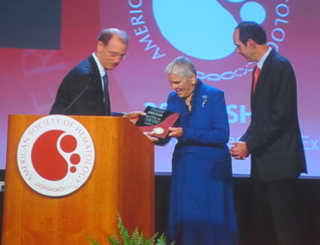
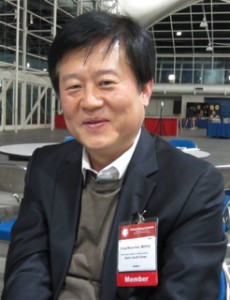
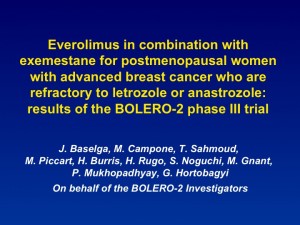 As a side note it is worth noting that the NEJM paper published yesterday contains the Stockholm data, not the updated data that will be presented later today that will show further improvement in progression free survival (as compared to placebo) in post menopausal ER+ HER2- women who took everolimus combined with exemestane.
As a side note it is worth noting that the NEJM paper published yesterday contains the Stockholm data, not the updated data that will be presented later today that will show further improvement in progression free survival (as compared to placebo) in post menopausal ER+ HER2- women who took everolimus combined with exemestane.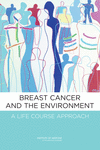
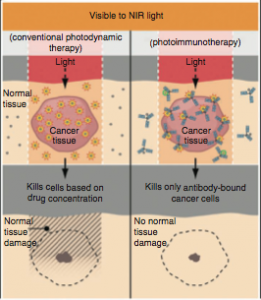
 Hait presented a plenary session on “overcoming barriers to new drug development” at the recent AACR-NCI-EORTC Molecular Targets and Cancer Therapeutics International Conference in San Francisco.
Hait presented a plenary session on “overcoming barriers to new drug development” at the recent AACR-NCI-EORTC Molecular Targets and Cancer Therapeutics International Conference in San Francisco.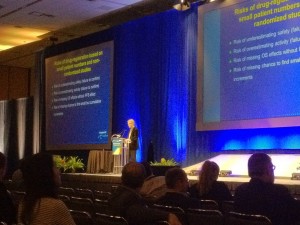 Jaap Verweij in his presentation used the examples of crizotinib, vismodegib, vemurafenib and imatinib in GIST as examples of drugs that had:
Jaap Verweij in his presentation used the examples of crizotinib, vismodegib, vemurafenib and imatinib in GIST as examples of drugs that had: The recent AACR-NCI-EORTC Molecular Targets and Cancer Therapeutics international conference in San Francisco was an informative meeting.
The recent AACR-NCI-EORTC Molecular Targets and Cancer Therapeutics international conference in San Francisco was an informative meeting.